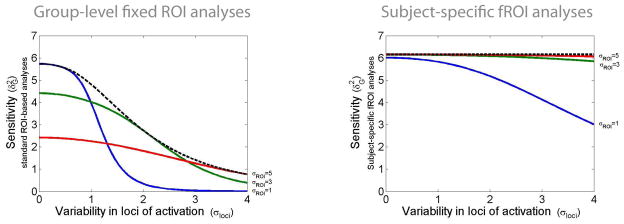Figure 3. Sensitivity of group-level fixed-ROI analyses (left) and subject-specific fROI analyses (right) as a function of spatial variability in the loci of activations and as a function of the ROI size.
Left: The sensitivity of multi-subject fixed-ROI analyses (y-axis) is plotted for different levels of inter-subject variability in the loci of activation (x-axis) for three different ROI sizes (solid lines). ROI sizes that approximately encompass the extent of activation across subjects (dotted line) are optimal, yet the sensitivity of such ROIs still decreases with increasing inter-subject variability in the loci of activation. Theoretical sensitivity values estimated for a spherical Gaussian-distributed activation with size parameter σact (fixed to a value of 1, representing approximately an activation extent of 12 voxels FWHM assuming 1 resel = 125 voxels) and with the loci of this activation varying randomly between subjects following a Gaussian distribution in center positions (with σloci varying from 0 to 4 characterizing the inter-subject variability in the loci of activation). The ROI is similarly characterized as encompassing an isotropic Gaussian sphere with size parameter σROI (varying from 1 to 5).
Right: The sensitivity of multi-subject subject-specific fROI analyses (y-axis) is plotted for different levels of inter-subject variability in the loci of activation (x-axis) for three different ROI sizes (solid lines). ROI sizes that minimally encompass the extent of activation across subjects are optimal (cf. matched filter theorem). In addition, the sensitivity of optimally-sized ROIs (dotted line) is not detrimentally affected by increasing inter-subject variability in the loci of activation.

